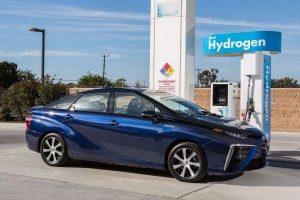The first thing you notice about the Mirai, Toyota’s new $62,000, four-door family sedan, is that it’s no Camry, an international symbol of bland conformity. First there are the in-your-face, angular grilles on the car’s front end. These deliver air to (and cool) a polymer fuel-cell stack under the hood. Then there’s the wavy, layered sides, meant to evoke a droplet of water. It looks like it was driven off the set of the Blade Runner sequel.
Just as the Prius has established itself as the first true mass-market hybrid, Toyota hopes the Mirai will one day become the first mass-market hydrogen car. On sale in Japan on Dec. 15, it will be available in the U.S. and Europe in late 2015 and has a driving range of 300 miles, much farther than most plug-in electrics can go. It also runs on the most abundant element in the universe and emits only heat and water—and none of the gases that lead to smog or contribute to global warming. “This is not an alternative to a gasoline vehicle,” says Scott Samuelsen, an engineer and director of the National Fuel Cell Research Center at the University of California at Irvine. “This is a quantum step up.”
The Mirai is hardly a speedster, though it’s quicker than a Prius. It can reach 100 kilometers (62 miles) per hour in 9.6 seconds. When you punch it, the car feels like an electric—there’s none of the vibration of a combustion engine. Driving the Mirai around a large, man-made island in Tokyo Bay called Odaiba is a little surreal. The interior is a Zen sanctuary of silence, save for the rush of wind passing around the vehicle and the occasional muffled sound of the suspension doing its work. The car can double as a mobile power station: A socket in the trunk can electrify the typical Japanese home for about a week in the event of an earthquake or other emergency.
As cool as the Mirai is, selling it is a hugely risky move. While fuel cells are a proven technology, used by NASA during Apollo missions in the 1960s to generate electricity and produce drinking water, a mass market for fuel-cell cars will require big investments in hydrogen fueling stations that may not be forthcoming. And, thanks in large part to Toyota itself, the auto industry has sunk serious money into hybrids, plug-in electrics, and advanced batteries in the expectation that these technologies will dominate the post-gasoline era, whenever that may be. “Every manufacturer has multiple hybrids and electrics coming,” says Mike Jackson, chief executive officer of AutoNation(AN), the largest U.S. retailer of new cars, trucks, and SUVs. “And here you have Toyota saying, ‘We’re not going to go full electric. The ultimate answer is fuel cells.’ ”

